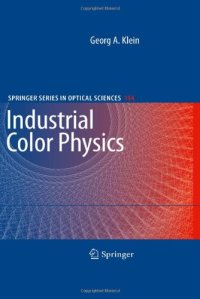
Ebook: Industrial Color Physics
Author: Georg A. Klein (auth.)
- Genre: Physics
- Tags: Optics Optoelectronics Plasmonics and Optical Devices, Microwaves RF and Optical Engineering, Industrial Chemistry/Chemical Engineering
- Series: Springer Series in Optical Sciences 154
- Year: 2010
- Publisher: Springer-Verlag New York
- Edition: 1
- Language: English
- pdf
This unique book starts with a short historical overview of the development of the theories of color vision and applications of industrial color physics. The three dominant factors producing color - light source, color sample, and observer - are described in detail. The standardized color spaces are shown and related color values are applied to characteristic color qualities of absorption as well as of effect colorants. The fundamentals of spectrometric and colorimetric measuring techniques together with specific applications are described. Theoretical models for radiative transfer in transparent, translucent, and opaque layers are detailed; the two, three, and multi-flux approximations are presented for the first time in a coherent formalism. These methods constitute the fundamentals not only for the important classical methods, but also modern methods of recipe prediction applicable to all known colorants.
The text is supplied with 52 tables, more than 200 partially colored illustrations, an appendix, and a detailed bibliography. This work is recommended particularly for physicists, chemists, and engineers in color industry and related fields of research, development, production, and processing; this work provides the fundamentals over the widespread physical properties and applications of absorption and effect colorants and is suitable for both the beginner and experienced developer.
The author, Georg A. Klein, was awarded his Ph. D. in polymer physics from the University of Mainz, Germany. After several years of R&D in the chemical industry, he became a professor for physics, color physics, and technology of polymers at the University of Applied Sciences in Stuttgart. His extensive decades-long experience in color physics and color technology in Germany and abroad is condensed in the present book.
This unique book starts with a short historical overview of the development of the theories and applications of industrial color physics. The three dominant factors producing color - light source, color sample, and observer - are described in detail. The standardized color spaces are shown and related color values are applied to characteristic color qualities of absorption as well as of effect colorants. The fundamentals of spectrometric and colorimetric measuring techniques together with specific applications are described. Theoretical models for radiative transfer in transparent, translucent, and opaque layers are detailed; the two, three, and multi-flux approximations are presented for the first time in a coherent formalism. These methods constitute the fundamentals not only for the important classical methods, but also modern methods of recipe prediction applicable to all known colorants.
The work describes in detail the fundamentals as well as the latest developments in research, in particular to be able to work extensively in the far-reaching fields of industrial color physics.